Widely available in pet stores and from breeders, rainbow guppies are considered beginner aquarium fish that are easy to care for and graceful to look at.
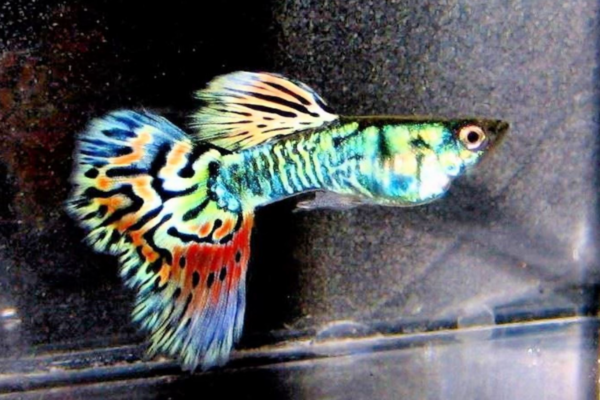
However, there isn’t one fish species called rainbow guppy. All fancy guppies, including Cobra, Moscow, Delta Tail, and Neon, come under the common name of “Rainbow Guppy”.
While rainbow guppies are typically pretty easy to care for, you still need to follow a guideline to provide the best care. In this article, I will help you comprehend all the necessary information about rainbow guppies.
Table of Contents
Rainbow Guppy Overview
Guppies, the colorful species of small freshwater fish native to South America, are scientifically known as Poecilia reticulata. Guppies were domesticated long ago due to their colorful streamlined body and flowing fins.
Their remarkable ability to adapt and survive with limited resources makes them a beginner-friendly species. For example, guppies develop more vibrant colors in predator-rich environments to attract mates and distract predators.
However, years of selective breeding have made them more vibrant and attractive.
| Information Chart | Rainbow Guppy |
| Scientific Name: | Poecilia reticulata |
| Family: | Poeciliidae |
| Care Level: | Low to Intermediate |
| Temperament: | Peaceful and friendly |
| Color: | Different species exhibit different polychromic varieties. |
| Lifespan: | 2 to 3 years. |
| Size: | Male: 1.2 to 2.4 inches Female: 1.6 to 2.4 inches |
| Diet: | Natural diet: algae and small invertebrates Domestic Diet: Commercial food, Frozen bloodworms, veggies. |
| Minimum Tank Size: | 10 gallons for a group of up to 5 guppies |
| Temperature: | 75 to 82 F |
| WaterConditions: | pH: Slightly Alkaline 6.8 to 7.8 Hardness: 143 to 214 ppm (KH) and 107 to 357 ppm (GH) |
| Tank Mate Compatibility | TetrasSwordtailsPlatiesMolliesCorydoras Catfish |
Appearance
Being dimorphic, male and female rainbow guppies vastly differ in both color and pattern. Guppies found in pet stores looking gracious and flattering are mostly males. Female guppies, on the other hand, have subdued coloration and shorter fins.
Shape-wise, guppies are small and have slender bodies. Males are typically more slender and streamlined than females.
Depending on the strain or variety of the guppies, the colors and textures may vary. Colors like red, green, blue, and purple are pretty common, while metallic and iridescent colors are also visible in some guppies.
Guppies exhibit various patterns on their body and fins. Common ones include spots, stripes, bars, and intricate patterns.
4 types of primary fins are visible on guppies.
- Dorsal Fin: Large and fan-shaped, the dorsal fin is located in the back.
- Caudal Fins: Comes in rounded, triangular, and lyre-shapes, caudal fin is the tail fin of the rainbow guppies.
- Anal Fin: Found on the underside of the fish near the tail.
- Pectoral and Pelvic Fins: Paired fins that are found on the upper and lower sides of the fish.
Among them, the dorsal and caudal fins are the ones that give the rainbow guppies their characteristic look.
Types of Rainbow Guppy
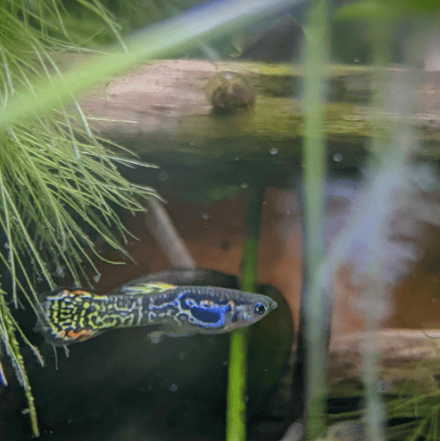
As mentioned, rainbow guppy is the general name for all varieties of fancy guppies. A few of them are:
Cobra Guppy
Cobra guppies feature a darker body color, usually in dark blue or green, with a metallic sheen. Resembling the patterns of a spread hood of a cobra, their most striking feature is the color patterns on their dorsal fin and tail.
The colors typically are in contrasting colors, such as red, orange, yellow, or white, and extend outwards from the center of the fin.
Moscow Guppy
Focused on the intensity and the depth, Moscow Guppies showcase metallic dark colors throughout their body and fins. The metallic colors vary between shades of blue, purple, green, red, and even black.
Moscow Guppies are known for their solid colors more than striking patterns.
Neon Blue Guppy
Superfluous to say, Neon Blue Guppies are…neon blue. They display bright blue hues throughout their body and fins. The colors may cover their whole body or concentrate on certain areas like their tail or fins.
The fins may also exhibit transparent or translucent areas, adding to their visual appeal. However, the shades of blue and pattern may vary with individual fish.
Tuxedo Guppy
Resembling the color combination of a tuxedo suit, Tuxedo Guppies typically exhibit black and gray on their body and a brighter color (usually white) on their fins. The brighter color on the fin edges, creating contrast with the body, is also an appealing pattern.
Delta Tail Guppy
The most commonly found rainbow guppy, the Delta Tail, is known for its colorful and delta-shaped tail. Broad at the base and narrowing down at the tail, Delta Tail Guppies come in a wide range of colors, such as blue, green, red, and purple.
Lifespan of Rainbow Guppy
On average, the lifespan of rainbow guppies stretches from 2 to 3 years. However, depending on genetic makeup, water quality, and diet, it may prolong or fall short.
As an enthusiast, you need to know a few factors that may determine the lifespan of your beloved tropical wonders.
- Genetic Factors:
Owing to their highly adaptive nature, some guppies develop more resilience and longer life than others. However, some of them may have genetic predispositions to certain health issues—shortening their lifespan.
- Water Quality:
Regular water changes, filtration, and waste management increase the lifespan of guppies. Although being a resilient species, they equally enjoy living in a healthy aquatic environment.
Maintaining water parameters, such as ammonia, pH, hardness, nitrate, and nitrite, is also critical for the survival of your guppies.
- Diet:
High-quality pellets, flakes, and frozen treats can prolong your guppies’ lifespan. While guppies are carnivores and may eat whatever you offer, you should only provide a nutritional and balanced diet to them.
- Disease:
Guppies are susceptible to many diseases and infections. Taking proactive measures, such as quarantining new fish, monitoring their health, and isolating ill members, can help you keep them healthy and prolong their lifespan.
- Stress level
Providing a stress-free environment allows guppies to thrive. Aggressive tank mates, overcrowding, and toxin spikes can increase their stress levels and reduce their lifespan to a great degree.
- Breeding and age:
Male guppies live longer than their female counterparts due to the consensual and forced breeding habits of guppies. If you breed your guppies, excessive reproduction can shorten the lifespan of the female guppies.
Rainbow Guppy Size
The average length of male rainbow guppies is around 1.2 to 2.4 inches, and their height is typically around 0.6 to 1 inches. On the other hand, female guppies can grow up to 1.6 to 2.4 inches in length and 0.8 to 1.2 inches in height.
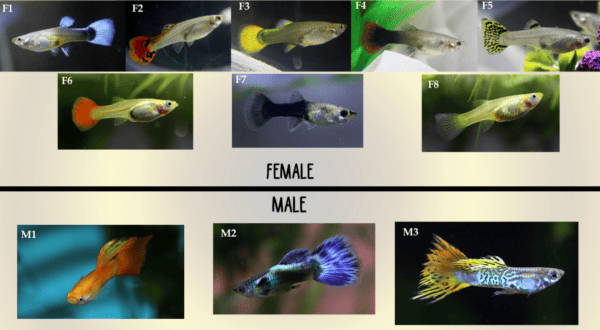
Many factors that determine their lifespan, like genetic factors, diet, and water quality, also influence their adult size. However, tank size and stocking density also are major contributing factors.
Overcrowding your aquarium can potentially make them fight for resources and cram space to swim. This, ultimately, shunts their growth and increases the probability of diseases and infections.
Natural Habitat and Origin
Guppies are native to South American freshwater rivers, streams, and stagnant waters. The highest concentration of guppies is found in the streams of countries like Brazil, Guyana, and Venezuela.
Being originated from tropical regions, guppies prefer a warm alkaline environment to live and reproduce. However, thanks to their adaptability, they’re found all over the globe in natural and artificial water bodies.
Their natural habitat varies from densely vegetated areas to brackish environments. Therefore, guppies have adapted to feed on a diverse carnivorous diet of algae, other organic matter, and aquatic insects.
Rainbow Guppy Care & Tank Set-Up
Moving on from the overview, let’s dive into a more detailed discussion of rainbow guppy care and tank set-up. We’ll discuss tank size, specification, water parameters, and landscaping for rainbow guppies in this section.
Tank Size and Specifications
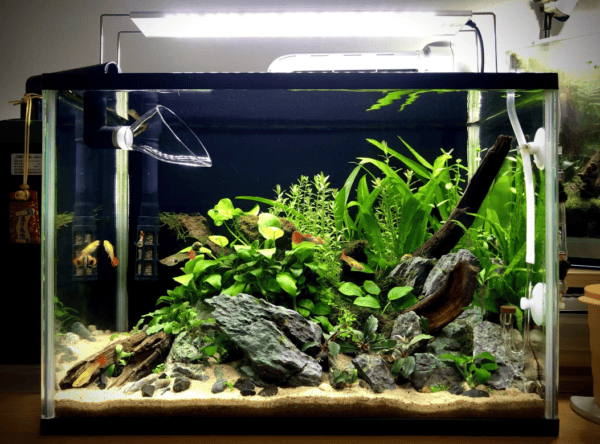
Tank size and tank specifications play essential roles in the health and growth of any aquatic animal, including rainbow guppies.
Optimum Tank Size
If your tank is dedicated to rainbow guppies, you may keep up to 5 guppies in a 10-gallon setup. For community tanks, it’s best to provide ample space for your guppies to hide and swim around.
For a 10-gallon tank, the approximate dimensions would be 20 inches (50 cm) in length, 10 inches (25 cm) in width, and 12 inches (30 cm) in height. But, you may experiment with the dimensions as long as you give ample space for them to swim horizontally.
To calculate the volume of your tanks by dimensions, use:
Volume (cu in) = Length (in) X Width (in) X Height (in)
231 cubic inches = 1 US gallon
1 US Gallon = 3.7854 liters
Filter Type
As with any tank setup, mechanical and biological filtration systems are a must for rainbow guppy aquariums. While you may install them separately, canister filters are a better alternative for the same.
However, given their small size and low bioload, you don’t need to employ a high-capacity filtration system. Additionally, a high-capacity filter motor may harm the guppies with its powerful suction and flow rate.
A few suitable filters and filter media may include:
- HOB Filter: Suitable hang-on-the-back filters are widely popular for guppy tanks. They offer great mechanical and biological filtration.
- Sponge Filter: Fixated with the air pump, sponge filters are great for guppy tanks, given their gentle nature of filtration.
- Canister Filter: Flow-adjustable canister filters may be used with baffles or spray bars to restrict flow rate.
- Mechanical Media: Filter floss and sponge pads.
- Biological Media: Ceramic rings, bio balls, bio-foam.
- Chemical Media: Not necessary for guppy tanks.
Substrate
Although a few guppy keepers choose to go bare bottom, having a suitable substrate helps provide beneficial bacteria with a larger surface area to grow. Substrates that are suitable for rainbow guppy tanks are:
- Fine gravel: Resembling their natural habitat, fine gravel from 1 to 3 mm is suitable for guppy tanks. In addition to offering a large surface area to bacteria, it’s easy to maintain and prevents small fries from getting trapped.
- Sand: Similar to fine gravel, sand also emulates the natural habitat of guppies. Moreover, light-colored sand highlights the vibrant colors of the species.
- Plant substrate: Many guppy keepers choose plants as their tank background to contrast with the metallic colors. Choose plant-specific nutrient-rich substrates if you want to go that way.
Pro tip: When using substrates, always rinse them before putting them into the aquarium. It’ll remove any chemicals or dyes harmful to the guppies.
How many rainbow Guppies can you fit in a 10-gallon tank?
3-5 guppies can be kept in a 10-gallon tank.
Water Parameters for Rainbow Guppy
Having a thorough understanding of suitable water parameters and how to adjust them are critical to sustaining your guppy aquarium.
75 to 82 F
pH: Slightly Alkaline 6.8 to 7.8
Hardness: 143 to 214 ppm (KH) and 107 to 357 ppm (GH)
Water Temperature
For most species of rainbow guppies, the optimum water temperature is between 75 to 82F (23 to 27C). Even though guppies can survive in colder or warmer water, we recommend maintaining it to the optimum level mentioned.
Here is how to do it:
To increase the temperature:
- The most common and effective method to increase water temperature is to use an aquarium heater. Most good quality heaters come with an auto cut-off feature to maintain the temperature.
- Increasing room temperature is another effective method. Using a heater or central heating system in your room, adjust the temperature to the desired level. It’ll gradually increase the water temperature.
- Heating pads work similarly to aquarium heaters but are safer to use. The absence of the risk of electrocution and localized heating makes it a popular choice among hobbyists.
To Decrease the temperature:
- Aquarium chillers are used to reduce the water temperature to the desired level. As heaters, they also are equipped with auto cut-off features.
- Placing a fan near the surface of the aquarium will reduce the water temperature by evaporating more surface water. However, ensure that the fan isn’t directly facing the surface.
- You may also use ice packs or frozen water bottles to reduce water temperature.
- Performing water changes with colder water will also reduce the temperature. But, it isn’t as sustainable as the other methods mentioned.
Water Flow Rate
Guppies thrive in slow to moderate water flow. They actively avoid excessively deep fast-moving waters due to their lack of strength and agility. A flow rate in the range of 40 to 60 GPH is optimum for the guppies to thrive.
If you’re using a canister filter, consider getting a flow-adjustment valve to maintain the low currents. However, many premium canister filters come equipped with adjustment features.
While a lot of guppy keepers prefer a slightly higher current according to their preference, we recommend starting at a slower rate and monitoring your guppies’ health and well-being. Too much current can cause stress and hinder their growth.
pH Level
Guppies prefer a slightly alkaline pH of 6.8 to 7.8. While they can survive in more acidic or basic environments, they thrive in this range. Here is how you can manage your aquarium’s pH level:
Increasing pH levels:
- Crushed corals or limestone help increase pH levels gradually. They release carbonates in the water to increase alkalinity. Place them in a filter bag for more effective usage.
- Sparingly using baking soda or sodium bicarbonate can increase the pH levels of your aquarium. However, stay cautious of pH spikes.
- pH buffering products can be used to buff the pH up. Make sure to follow the recommended dosage.
Decreasing pH levels
- Driftwood or peat moss releases tanning and organic acids in the water to help lower pH levels.
- Using RO water can help dilute the alkalinity of the water to lower the pH levels. However, mix it with tap water or existing aquarium water, as they lack minerals. You may also need to facilitate a remineralization process to use RO water.
- pH reducers may also be used to maintain the appropriate levels.
Water Hardness
Two types of water hardness are observed in aquatic systems: General hardness (GH) and Carbonate Hardness (KH). In a guppy tank, a GH of 107 to 357 ppm and a KH of 143 to 214 ppm are recommended.
FYI, GH refers to the measure of concentration of dissolved minerals in the water, and KH refers to the concentration of carbonate ions in the water.
A higher GH and KH potentially hinder the ability of your guppies to reproduce and reduce fry survival rate. It may also introduce an element of stress to your guppies.
In comparison, a lower GH and KH can stall the growth of your guppies and destabilize the pH levels in your aquarium.
Partial water changes, using specific filter media, and using pH buffering products can help you maintain the water hardness parameters.
Rainbow Guppy Tank Landscape
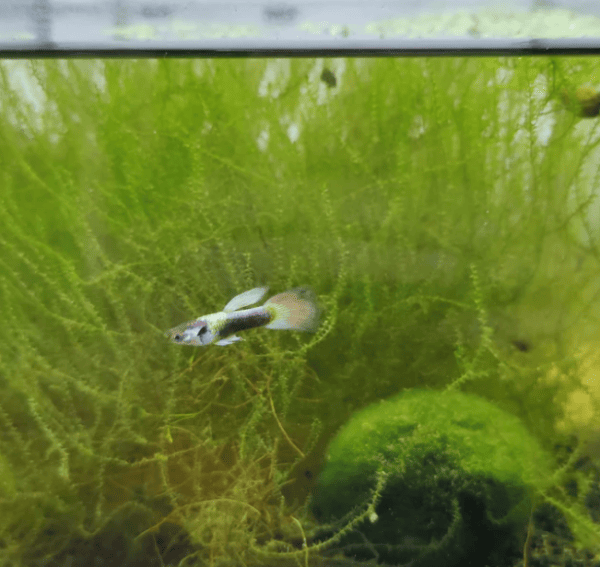
Guppies need a lot of crannies to hide and fulfill their natural instinct of navigating through the vegetation. Here are a few pointers to remember when deciding on your rainbow guppy tank landscape.
Best Plants for Rainbow Guppy Tanks
Some common plants for guppy tanks are:
- Java Moss: Can be attached to the rocks and driftwood. Provides a hiding place for guppies.
- Java Fern: Broad, green leaves provide ample space for guppies to hide. Can also be anchored to stones and driftwood.
- Amazon Sword: A larger plant with long, broad leaves to create a lush background. Helps maintain water quality.
- Anubias: Low-maintenance and sturdy plant with dark green leaves.
- Water Wisteria: A fast-growing plant with delicate, feathery leaves. It helps with water filtration and provides hiding spots for guppies.
- Water Sprite: A floating or rooted plant that has fine, lacy leaves.
- Hornwort: A floating or anchored plant with dense, feathery foliage.
Worst Plants for Rainbow Guppy Tanks
The worst plants for rainbow guppy tanks are:
- Water Hyacinth: Although visually appealing, water hyacinth can grow rapidly and cover the surface of the water.
- Duckweed: A small floating plant that can multiply quickly, forming dense mats on the water surface. Hinders water circulation.
- Dieffenbachia: While guppies are generally not prone to nibbling on plants, it’s still important to avoid potentially toxic plants like this in their tank.
Decorations for Rainbow Guppy Tanks
Any decorations with enough hiding space and interesting structures are appropriate for rainbow guppies. Some of them are:
- Rocks and Driftwood
- Caves and Tunnels
- Artificial plants with smooth edges.
- Floating plants
Behavior and Temperament
Rainbow guppies exhibit a few behavioral traits that you may find interesting.
Continuously exploring the environment, guppies are pretty active swimmers. They love swimming near the surface of the water.
Guppies are social fish and thrive when kept in a group. They’re less anxious when surrounded by their own kind.
Although territorial behavior among male guppies is observed rarely, they generally are a pretty peaceful species with no issues going along with other community tank members.
During courtship, elaborate fin displays are performed by the male guppies. The purpose of the dance is to attract females and intimidate other male guppies.
Guppies are livebearers, they don’t lay eggs, but give birth to fries.
Rainbow Guppy Tank Mates
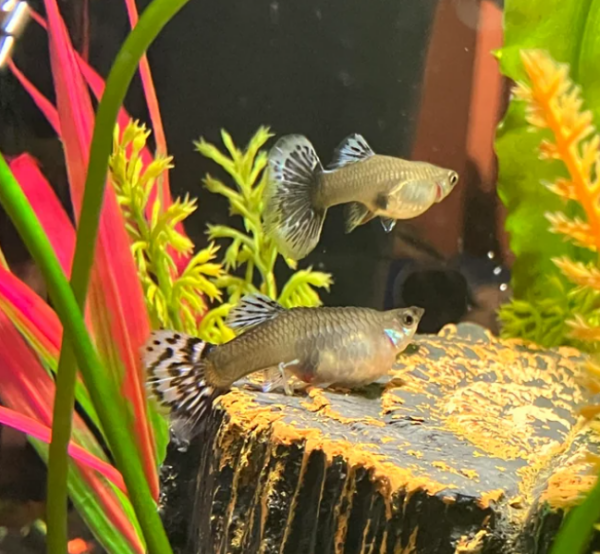
If you’re preparing a community tank, knowing the best and worst tank mates for rainbow guppies is essential.
Ideal Rainbow Guppy Tank Mates
Ensure the rainbow guppy tank mates are peaceful, small-sized, and compatible with similar water parameters. Here are the most common ones:
- Other guppy variants.
- Tetras
- Rasboras
- Corydoras Catfish
- Small Livebearers like Swordtails.
- Dwarf Gouramis
- Snails and Shrimps
Bad Tank Mates for Rainbow Guppy
Aggressive, bigger-sized, and incompatible water parameter fish are considered bad tank mates for rainbow guppies. Examples of some of them are:
- Cichlids
- Tiger Barbs
- Serpae Tetra
- Red-Tail Shark
- Oscars
- Arowanas
- Danios
- Tinfoil Barb
Breeding Rainbow Guppy
Breeding guppies is a relatively straightforward process. Follow the step-by-step instruction to facilitate it:
- Set up a breeding tank: Prepare a bare bottom tank dedicated to the purpose of breeding and maintain the temperature to 74-82F. Use a sponge filter.
- Choose breeding stock: Choose adult guppies that are healthy and showing signs of readiness. Choose 1 male for every 2-3 females.
- Place the guppies: Place the male and females in the breeding tank. Ensure that the male is showing courtship behavior and the females are showing receptive signs, such as a darkening spot on the abdomen.
- The male will use his gonopodium to fertilize the eggs inside the female.
- Provide hiding places for the females to rest and gestate.
- The gestation period is around 4-6 weeks. Once the fries are born, separate them from the parents and maintain their diet with powdered flakes and infusoria.
- The fries are self-sufficient. However, closely monitor water parameters and the health of the fries to increase the survival rate.
As mentioned before, rainbow guppies exhibit dimorphism. Males and females of the species look vastly different and differ hugely in their color, size, fins, and body shape.
Common Diseases and Their Treatment
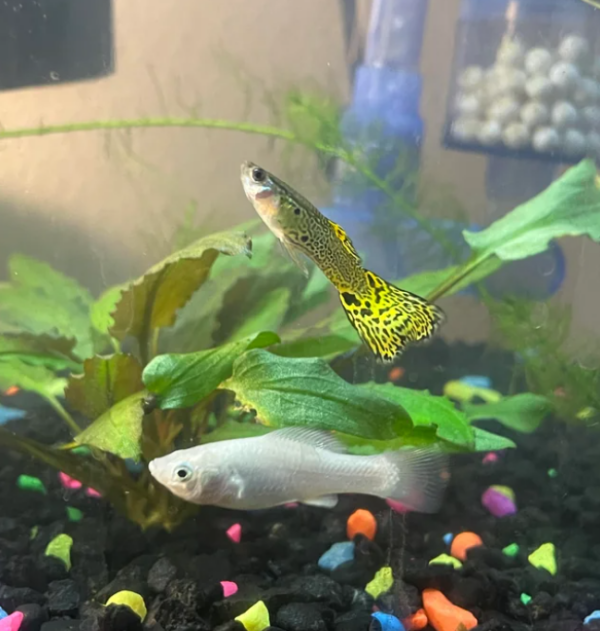
Although resilient, guppies also are susceptible to a few diseases.
Fin Rot
Causing fins to deteriorate and resulting in frayed edges, fin rot disease is treatable through regular water changes and increasing the water temperature.
Velvet Disease
Velvet is a parasitic disease caused by Oodinium parasites. It appears as a yellowish-gold or velvet-like coating on the fish’s body, fins, and gills.
Improving water quality through regular water changes, and administering formulated antibiotic medications specifically can work.
Dropsy
Fluid accumulation and abdomen swelling are major symptoms of Dropsy. Water changes, antibiotics, and a balanced diet are effective treatments.
Are Rainbow Guppies Right For You?
Whether you’re a beginner hobbyist or an experienced keeper, rainbow guppies are right for you. Follow the points mentioned in the article and monitor the water parameters, diet, and behavior of your rainbow guppies to maintain a healthy and happy tank.
Conclusion
By following the guidelines in this comprehensive guide, you can provide the best possible care for your rainbow guppies and bring vibrant colors to your aquarium.
